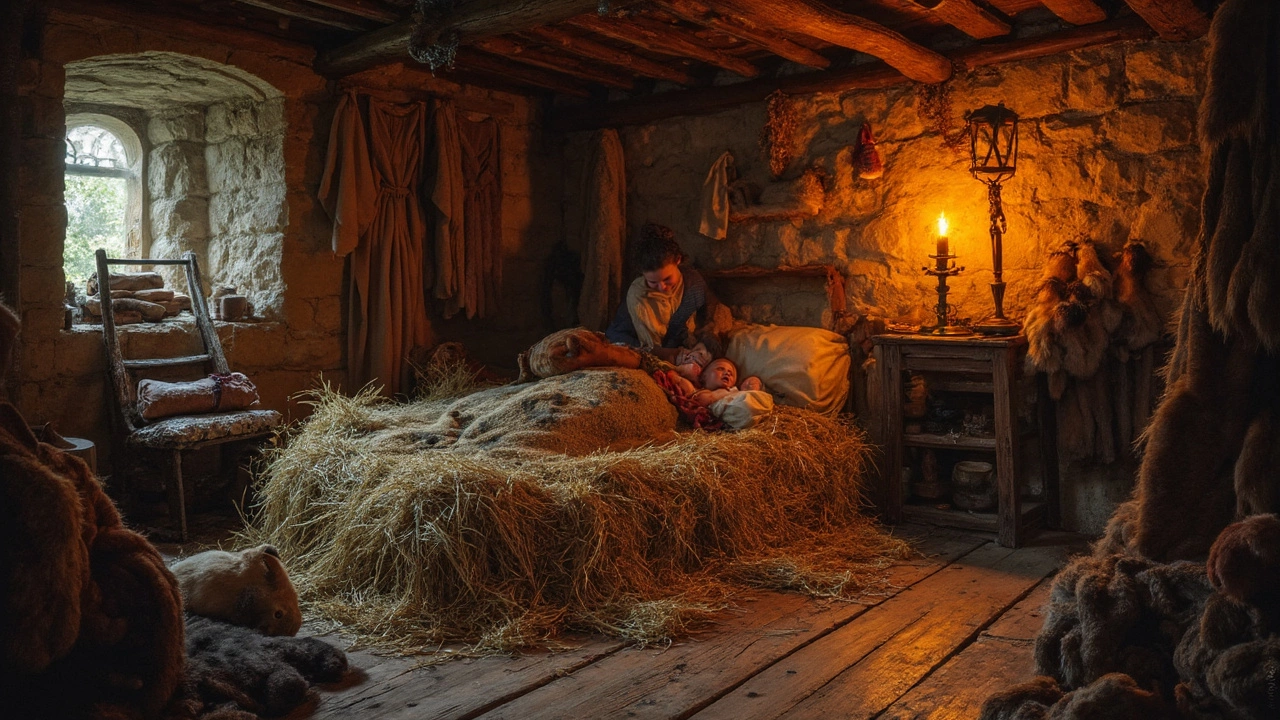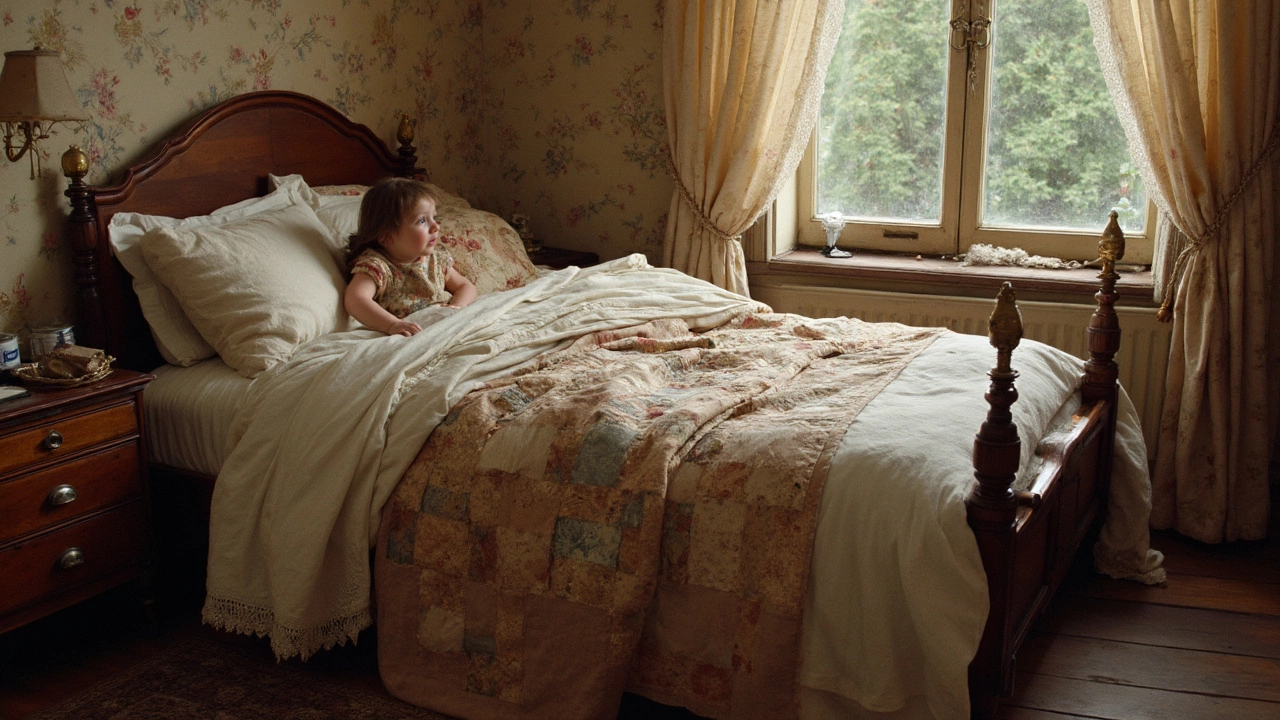Old Meaning of Bedding: What Did It Really Refer To?
 Apr, 29 2025
Apr, 29 2025
If you hear someone say 'bedding' today, you probably picture matching sheets, pillows, and a cozy duvet. But go back a few hundred years, and bedding meant something totally different. Back then, bedding wasn't a stylish set you ordered online—it was anything people used for sleeping, and most of the time, it wasn’t even placed on a real bed frame.
Forget about memory foam or cooling pillows. In the past, folks often slept on piles of straw, grass, old clothing, or animal skins right on the floor. The fancier families might stuff big sacks with feathers or wool, but common people made do with whatever they had. Bedding as a word just meant the stuff between you and the cold, hard ground.
- How Bedding Looked Centuries Ago
- Materials Used for Old Bedding
- The Role of Bedding in Everyday Life
- Tips for Spotting Antique Bedding
How Bedding Looked Centuries Ago
Long before you could pick up a king-size comforter at the nearest superstore, folks thought of old meaning of bedding in a very different way. Back in medieval Europe, most regular people didn’t even have beds. Imagine rolling out a sack of straw, maybe adding some itchy wool or old clothes—yep, that was your sleeping setup. Even the word 'bedding' meant whatever separated your body from the hard floor, not just sheets and blankets.
If you visit old castles or colonial-era houses, you’ll notice beds that sit high up off the ground. That wasn’t stylish—it was to stay away from drafts, rats, and bugs. To climb up, people actually used tiny steps or stools. But here’s what’s wild: even those raised wooden frames were rare outside the wealthy. Most folks in villages slept on mattresses called 'pallets,' usually nothing more than bundled straw wrapped in cheap cloth, which they’d roll up and store in the corner during the day.
Royalty and nobles used what they called a 'featherbed', stuffed with feathers for some softness and warmth. It cost a fortune, so the rich showed them off as a sign of status. Kids and the poor hardly ever got to use them. Bedding arrangements could get crowded, too—one shared blanket for all the siblings, and sometimes even the family goat.
- Commoners: Straw pallets, old rags, or animal skins
- Middle class: Wool-stuffed mattresses, rough linen covers
- Aristocrats: Featherbeds, multiple layers of fine sheets, colorful hangings for warmth
It was only in the 18th and 19th centuries that true bed frames and higher quality bedding started trickling down to regular people. Before that, bedding history was about making do, not matching colors and comfort thread counts.
Materials Used for Old Bedding
People didn’t always have the luxury of soft sheets or memory foam—they made do with what they could find. The old meaning of bedding was super practical, all about staying warm and dry, not looking pretty.
Centuries ago, if you peeked into a regular home, you’d likely find bedding stuffed with straw, hay, or even dried leaves. That was the most common and cheapest option. Some families used rags or old clothes. Wool got popular later since it’s warm and holds up for a long time. If you were really lucky or wealthy, you’d have bedding filled with goose feathers or down—still considered some of the best stuffing today.
Animal skins played a big part, especially before central heat. People layered furs from sheep, goats, or even deer on the floor or over themselves for warmth. In really cold spots, stacking fur, straw, and old blankets together was pretty standard.
Here’s a quick look at what was commonly used for bedding origins and stuffing:
- Straw and hay (cheap, easy to get, replaced often)
- Wool (cozy, lasts a long time, but pricier)
- Feathers or down (luxury level, mostly for the rich)
- Animal skins and furs (big for warmth in harsh winters)
- Dried leaves or grass (rural, basic, usually just for the poor)
- Old cloth or rags (sometimes as a last resort)
In colonial America, straw mattresses were called "ticks." People stuffed them fat at first, but over time, the straw flattened and had to be refilled. Sewn sacks were used to keep things contained, but nothing was really sealed—critters sometimes found their way in too. If you’ve ever opened up an old mattress at an antique shop or old inn, you might actually spot straw, feathers, or even faded wool peeking out.
People didn’t have set standards for bedding materials—it all depended on the climate, their farm animals, and how much cash they had in their pocket. Next time your kids complain about their lumpy pillow, you can let them know how much tougher bedtime was a few hundred years ago.

The Role of Bedding in Everyday Life
Back in the day, old meaning of bedding was all about getting by with what you had. Forget about sleep being this luxury time for rest. Bedding needed to do a few things: keep people warm, protect them from bugs, and give even a little bit of cushion from the floor. For the average family, rolling out worn blankets or layers of hay at night was just the nightly routine.
People with more money did things differently. Wealthy folks might have feather mattresses, wool-filled bolsters, or even early versions of sleeping bags lined with fur. Some old houses—especially in colder places—kept spare bedsheets near the kitchen fire, so they’d be warm when it was time for bed.
Bedding was a family asset. It got handed down, traded, and even listed in wills. Nobody threw out a decent blanket if it could be patched. When kids like mine—Dorian or Selena—outgrew their baby bedding, it often got cut up and reused as rags or pet mats. Nothing went to waste, especially in big country households that had more mouths than spare cash.
For regular folks in North America and Europe, here’s what you'd usually see around 1750-1850:
- Loose straw or rushes covered with homespun sheets
- Wool or feather ticks for those who could afford it
- Rough woven blankets for warmth
- Animal skins or heavy coats in harsh winters
City dwellers had their own take. Boarding houses sometimes rented out just the bedding—so you’d bring your own pillow if you wanted something clean. In crowded urban homes, several people shared the same makeshift bed. A pile of bedding on the floor by the fire could be considered a decent night's sleep.
Bedding wasn’t just something for bedtime either. It doubled as picnic cloths, cloaks for travel, or padding for a sore back—anything to make life a little easier. That’s the thing about the old meaning of bedding: it was practical, always a little bit patched up, and usually pulled double duty.
| Item | Main Purpose | Common Materials |
|---|---|---|
| Mattress Base | Cushion from floor | Straw, hay, leaves |
| Top Cover | Warmth | Wool, animal skins |
| Pillow | Head support | Feathers, rags |
Tips for Spotting Antique Bedding
Hunting for real old bedding at a flea market or attic? It’s not always easy to tell the difference between a true antique and just something that’s a bit worn out. Here’s what actually matters when you want to spot the real thing:
- Check the materials: Old bedding wasn’t made with polyester, microfiber, or bright synthetics. You’re looking for rough linen, thick cotton, coarse wool, or even patches of faded canvas. If it feels silky or modern, it’s probably not the real old-fashioned deal.
- Look at stitching and seams: Handmade bedding usually means big, uneven stitches or even visible repairs where stuff was patched up. There weren’t big sewing machines cranking out identical sheets until the 1800s, so keep an eye out for quirks and small sewing mistakes.
- Notice the color: Old bedding isn’t usually bright white or patterned like something from last season’s catalog. You might find yellowed fabric, slight browning, or some faded colored stripes, especially on grain sack ticking—the heavyweight stuff filled with feathers or straw.
- Smell matters: Not the most fun trick, but the scent can give clues. Genuine antique linens sometimes have a musty, earthy smell that just sticks around despite washing. But if it smells heavily of chemicals, it could be a newer reproduction.
If you want to level-up your search, learn about bedding sizes from different centuries. Beds weren’t always twin, queen, or king—the mattresses were often short and narrow. If it seems small, that could mean you’ve got an older piece.
| Material | Common in Antique Bedding? |
|---|---|
| Linen | Yes |
| Cotton (Coarse) | Yes |
| Wool | Yes |
| Polyester | No |
| Silk (Modern, Smooth) | No |
Keep these tips in mind, and don’t get fooled by gimmicks. Sellers sometimes use words like "vintage" for things that are just a few years old. “Antique” usually means a hundred years or older, so check the details. If you spot hand-stitched patches, rough textures, and oddball sizes, you might be holding a little piece of bedding history.